#genuinely i respect his angle so much. so clean. so artful. this is the best thing drakes existence caused on earth
Text
kendrick lamar murdering drake live on tv continues

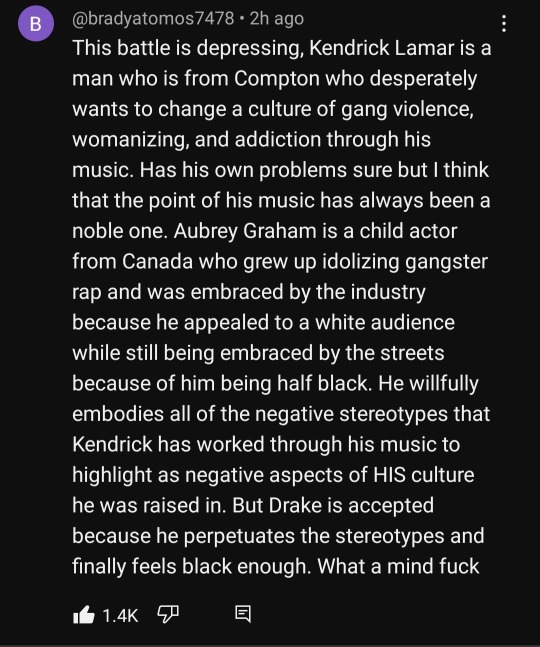
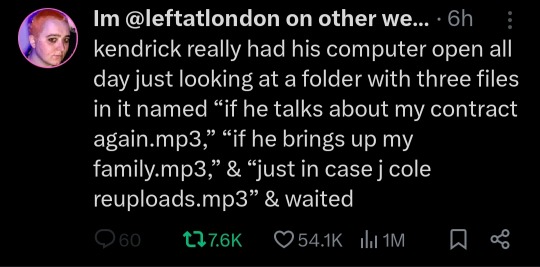
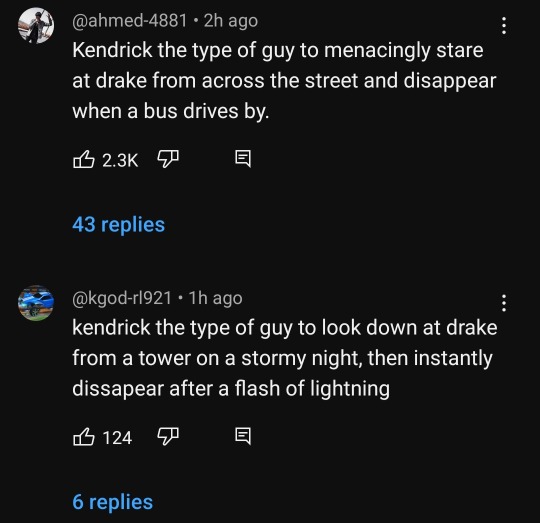
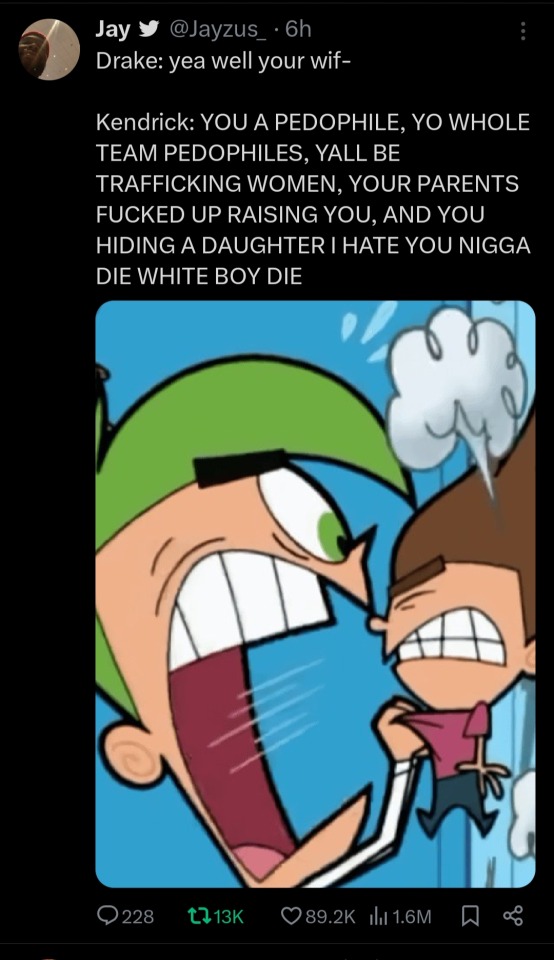
#mypost#kendrick lamar#k.#drake#genuinely i respect his angle so much. so clean. so artful. this is the best thing drakes existence caused on earth#righteous rage kendrick is something else#1k
5K notes
·
View notes
Photo

“I heard your voice, so I came... Aoba-san.”
Hooo-boy, if that doesn’t get me emotional every single time. Call it my bias for eccentric bundles of sunshine and softness, or my crippling weakness for the secretly-handsome-and-devastatingly-earnest type, but you can’t change my mind: Clear is, hands down, DMMD’s best love interest. Character development-wise, thematically, romantically, he nails every trial thrown at him, gets his man, and proceeds to break your heart in the tenderest, sincerest way possible. I am hopping with Huge Fan Energy, so this post is gonna be unapologetically long and self-indulgent and grossly enthusiastic. Yeeeee.
————
Look, DMMD meta analysis has been done to death, I get it. This game is old. But I think it stands as testament to its excellent production that it’s still a game worth revisiting years later — especially during these times when social contact is so hard pressed to come by and we all rabidly devour digital media like a horde of screeching feral gremlins. (Have you seen Netflix’s stock value now? The exploding MMO server populations? Astonishing.) It’s pure, simple human nature to want to connect, to cling to members of our network out of biological imperative and our psychological dependency on each other. As cold and primitive at that sounds, social contact also fulfills us on a higher level: the community is always stronger than the individual; genuine trust begets a mutually supportive relationship of exchange and evolution. People learn from each other, and grow into stronger, wiser, better versions of themselves.
Yeah, I’m being deliberately obtuse about this. Of course I’m talking about Clear. Clear, who is a robot. Clear, who is nearly childlike in his insatiable curiosity regarding the human condition.
And it’s a classic literary tactic, using non-human entities to question the intangible constructs of a concept like ‘humanity’ — think Frankenstein, or Tokyo Ghoul, or Detroit: Become Human, among so, so many works in various media — all tackling that question from countless angles, all with varying measures of success. What does it mean to be human? To be good? Who are we, and where do we stand in the grand scheme of things? Is there even a scheme to follow? … Wait, what?
Jokes aside, there are so many ways that the whole approaching-human-yet-not-quite-there schtick can be abused into edgy, joyless existential griping. Nothing wrong with that if it’s what you’re looking for, except that we’re talking about a boys’ love game here. But DMMD neatly, sweetly side steps that particular wrinkle, giving us a wonderfully grounded character to work with as a result.
Character Design — a see-through secret
Let’s start small: Clear’s design and premise. Unlike so many other lost, clueless robo-lambs across media, Clear does have a small guiding presence early on in his life. It takes the form of his grandfather, who teaches Clear about the world while also sheltering him from his origins. It means he learns enough to blend sufficiently into society; it also means that Clear has even more questions that sprout from his limited understanding of the world.
Told that he must never remove his mask lest he expose his identity as a non-human, Clear’s perpetual fear of rejection for what he is drives much of his eccentricity and challenges him throughout much of his route. As for the player, the mystery of what lies underneath his mask is a carrot that the writers get to dangle until the peak moment of emotional payoff. Even if it’s not hard to guess that there’s probably a hottie of legendary proportions stuck under there, there’s still significance in waiting for that good moment to happen. And when it does, it feels great.
His upbringing contextualizes and affirms his odd choice of fashion: deliberately generic, bashfully covered from the public eye, and colored nearly in pure white - the quintessential signal of a blank slate, of innocence. Contrasted with the rest of DMMD’s flashy, colorful crew, Clear is probably the most difficult to read on a superficial scale, not falling into the fiery, bare-chest sex appeal of a womanizer, or the techno-nerd rebel aesthetic that Noiz somehow rocks. Goofy weirdo? Possibly a serial killer? Honestly, both seem plausible at the start.
And that’s the funny thing, because as damn hard as he tries to physically cover himself up from society, Clear is irrepressibly true to his name: transparent to a fault. He’s a walking, talking contradiction, and it’s not hard to realize that this mysterious, masked stranger… is really just an open book. By far the most effusive and straightforward of the entire cast, his actions are wildly unconventional and sometimes wholly inexplicable. But given time to explain himself, he is always, always sincere in his intentions — and unlike the rest of the love interests, naturally inclined to offer bits of himself to Aoba. It doesn’t take the entire character arc to figure out his big, bad secret — our main character gets an inkling about halfway through his route — and what’s even better is that he embraces it, understanding that his abilities also allow him to protect what he cherishes: Aoba.
So what if he doesn’t fit into an easily recognizable box of daydream boyfriend material? He’s contradictory, and contradiction is interesting. Dons a gas mask, but isn’t an edgelord. Blandly dressed, but ridiculously charming. Unreadable and modestly intimidating — until he opens his mouth. Even without the benefit of traversing his route, there’s already so much good stuff to work with, and sure as hell, you’re kept guessing all the way to the end.
Character Development — from reckless devotion into complaisant subservience, complaisant subservience into mutual understanding. And then, of course: free will, and true love.
At its core, DMMD is about a dude with magic mind-melding powers and his merry band of attractive men with — surprise! — crippling emotional baggage. Each route follows the same pattern, simply remixing the individual character interactions and the pace of the program: Aoba finds himself isolated with the love interest, faces various communication issues varying on the scale of frustrating to downright dangerous, wanders into a sketchy section of Platinum Jail, bonds with the love interest over shared duress, breaks into the Oval Tower, faces mental assault by the big bad — and finally, finally, destroys those internal demons plaguing the love interest, releasing the couple onto the path of a real heart-to-heart conversation. And then, you know, the lovey-dovey stuff.
Here’s the thing: as far as romantic progression goes, it’s really not a bad structure. There’s room to bump heads, but also to bond. The Scrap scene is a thematically cohesive and clever way to squeeze in the full breadth of character backstory while simultaneously advancing the plot. In this part, Aoba must become the hero to each of his love interests and save them from themselves. Having become privy to each other’s deepest thoughts and reaching a mutual understanding of each other, their feelings afterwards slide much more naturally into romantic territory. They break free of Oval Tower, make their way home, and have hot, emotionally fulfilling sex or otherwise some variation on the last few steps. The end.
That is, except for Clear.
Clear’s route is refreshing in that he needs none of these things — the climax of his emotional arc actually comes a little after the halfway point of his route. When Clear’s true origins are revealed, he comes entirely clean to Aoba, fighting against his fear of rejection but also trusting that Aoba will listen. It’s a quiet, vulnerable moment, rather than the action-packed tension we normally experience during a Scrap scene.
That doesn’t mean it’s prematurely written in — it simply means that he reaches his potential faster than the other characters. Because of that, he’s free to pursue the next level of his route’s development much, much sooner in the timeline: he overcomes his fears of his appearance, he confesses his love to Aoba, he leaves the confines of a largely dubious master-servant relationship and allows himself to be Aoba’s equal. Clear’s sprite art mirrors his emotional transformation all the way through, exposing him to the literal bone — and Aoba’s affection for him doesn’t change a single bit. Beautiful.
The whammy of incredible moments doesn’t just stop there, though. I don’t exactly recall the order the routes DMMD is ideally meant to be played in, but I believe Clear’s is meant to be last. And if you do, I can guarantee that it becomes a hugely delightful gameplay experience — in order to achieve his good ending, you must do absolutely nothing with Scrap. It doesn’t just subvert our player expectations of proactively clicking and interacting with our love interests; it grabs the story by its thematic reins and yanks it all back to the forefront of our scene.
In every route besides Clear’s, Scrap is a tool used to insert Aoba’s influence into and interfere with his target’s mind. Using his powers of destruction, Aoba is able to prune whatever maligned thoughts are harming his target; in any conventional situation, using Scrap is the right choice.
But one of the central problems in Clear’s route is his conflict between the impulses of his conditioning and his desire to live freely as a human would. Breaking free of Toue’s programming is what initially made him unique; growing beyond the rules imposed by his grandfather is what makes him human. In the final conflict scene, Clear’s decision to destroy his key-lock is an action of true autonomy, made with perfect understanding of the consequences and a sincere, selflessly selfish desire to protect someone he loves. In order to receive his good end, you have to respect his decision. It doesn’t matter which option you pick — by using Scrap, Aoba turns his back on every positive choice he made with Clear and attempts to exert his authority over him. This is Aoba becoming Toue; this is Aoba trying to reinstate himself as ‘Master’ right as he approved Clear as his equal. That’s blatant hypocrisy, and it doesn’t matter if Aoba is trying to do it for Clear’s ‘own good’ — that’s not Aoba’s call to make. If you truly wish to respect Clear’s free will, you will stand by. This is the truth of the moment: Clear has no emotional blockages that Aoba needs to fix. Believe in him, just as he believed in you.
The path to his heart is, and always has been, clear. Scrap was never needed from the start.
While Aoba might be the main character, Clear is undeniably a hero in his own route just as much. Tirelessly earnest and always curious, he leaps headlong into the unknown and emerges with his newfound enlightenment. He’s unafraid of weathering trials, even to the point of accepting death, and returns anew from oblivion to a sweet, cathartic ending. That’s about as textbook hero’s journey as it gets — if that doesn’t make him unquestionably, certifiably, unconditionally human, then I will scream.
And only finally… there is the free end. The final CG is like a throwback to our first impression of him: indistinct, purposefully obscured from proper view. But this time, we know better — and so does Aoba. Looks were never what mattered in Clear’s route. If you were patient, and you were open-minded, and you listened… well, what we realize now is that Clear was doing the exact same thing for you, too.
From a carefree, aimless robot-man with only the gimmick of “eccentric ditz” to carry him forward, we get a supremely more interesting character by the end: a man who has graduated from the well-intentioned but claustrophobic conditioning of his childhood; a weapon who has defied the imperatives placed on him by his creator’s programming; a wanderer who has, through unconditional patience and empathy, discovered love, and striven to become a better person for it. Who was it that ever doubted Clear’s character? He’s the goddamn goodest boy that ever wanted to be a real boy. Of course Clear is human. And in fact, he does it better than every single one of the actually human love interests. You can’t change my mind.
The Romance — kindness is really fucking attractive, okay.
Like I’ve said earlier, I have my Big Fan Blinds stuck on pretty tight. I might be conjuring sparks from thin air. But I think every choice was a deliberate creative decision on the writers’ part, and they deserve all the kudos for it — I’m just the lucky player who gets to enjoy it. But aside from Noiz (who I also think is a perfect darling as well — I could go on and on about him), Clear’s route is a model example for consent and healthy relationships in VN storytelling. This is reciprocated on both sides: never does Aoba infringe on Clear’s boundaries, and neither does Clear. They’re sensitive to each other’s needs and concerns; they ask for permission and stop when it isn’t granted (and when it is, boy do they get frisky — I’m not complaining!) I don’t need to say much more, because I think that consent is both fantastic and yes, incredibly hot (the scene in DMMD is tons more sad, go play Re:connect!). Good writing shows off the massive erotic potential enthusiastic consent puts into intimacy, and Aoba’s and Clear’s relationship is honestly a dream playground. The point is, I think Aoba and Clear genuinely do find equal balance in their relationship by the end of his route (and certainly through Re:connect). If you follow through Re:connect’s storyline, there’s even more thematic richness that comes through in the form of Clear’s greatest asset: communication. The couple get to discuss the long-term implications of them being together; they both offer concerns, points, and assurances to the other, and it’s just a soft, honest moment not so unlike the worries of a real relationship. Hearing is kind of Clear’s motif sense, but it’s really great to see that Aoba also subtly picks it up, really flexes his own communication skills to better engage with Clear.
Point is, Clear’s route spoke to me on a lot of little levels. Design-wise, he’s already got a ton going for him, and his story builds upon it rather than against it, enriching his development and grounding him a little more solidly in the DMMD universe (and in my heart). His route, aside from being emotionally ruinous, carries a pretty solid chunk of world-building (only beaten out by Mink’s and Ren’s, probably), and the romance feels organic, healthy, and realistic. He’s not the only one with an excellent route, but he’s my favorite. If you read through all of this, you’re a real trooper and I’m extremely impressed. Thanks for tuning in. Peace.
#dramatical murder#dmmd#aoba seragaki#clear#dmmd clear#long ass emotional screeching#lOL I FORGOT TO DRAW IN THE UMBRELLA HANDLE ahA#fixed
86 notes
·
View notes
Text
Structure Research
Simon Kennedy
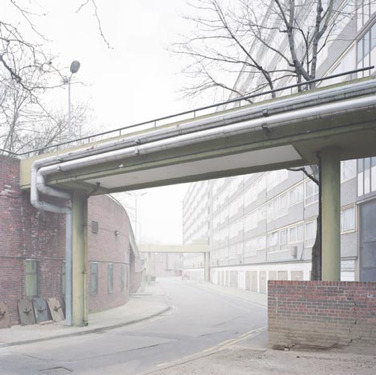
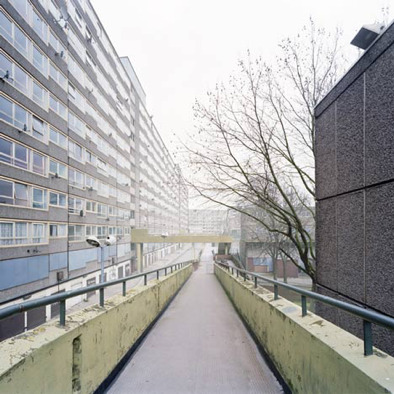
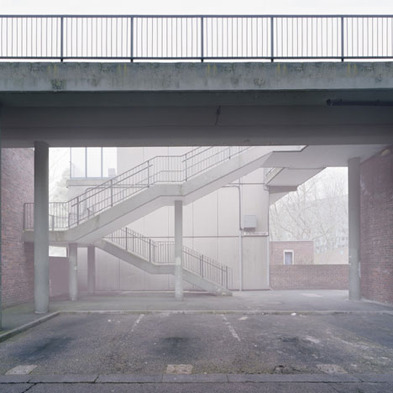
Simon Kennedy’s architectural photography is amazing in showing us not only the function of the structure but the environment it exists in. His study of Heygate estate especially interests me, due to Kennedy’s use of the plain/gloomy light to bring out the character of the area the structure exists in. In fact, he took a risk in using this kind of diffused/overblown light, but due to this project having taken place over the course of many months, I suspect his final images may be multiple exposures together.
https://www.dezeen.com/2010/12/01/heygate-abstracted-by-simon-kennedy/
Nick Guttridge
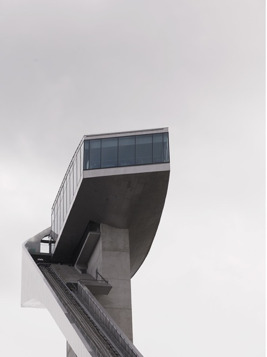


I really enjoy Guttridges style, it’s very clean and modern. In fact, when I look at his work I get a very surreal feeling but not in an obvious or over-bearing way. He seems to have an intense focus when it comes to his leading lines, encouraging the viewer to explore the complex image. I like the fact that in some images Guttridge left in people, as the architecture would not exist without peoples influence and are often built for people.
http://www.nickguttridge.com/lifestyle-travel
Bas Prince
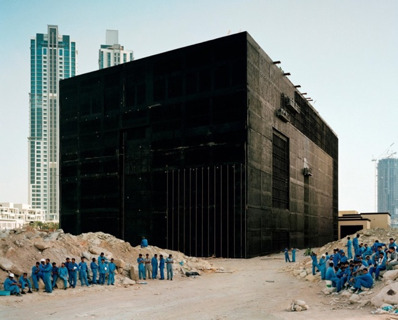

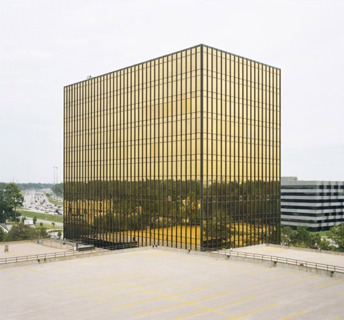
When looking at Bas Prince’s work, I always see landscapes. He truly focuses on the big picture, and really isolates structures within amazingly interesting landscapes and makes them even more interesting and very imposing buildings. I also love his simplistic approach when it comes to geometry, maybe it’s just the subject matter we see above but the simple block buildings are really dominating in the image and steal all the focus of me, the viewer.
http://www.bldgblog.com/tag/bas-princen/
Ralph Graf



Ralphs Graf’s work in the Bauhaus School of Art is fantastic. He has truly stayed true to the modernistic style of the building and its artistic history in Germany. The square windows, plain colours and hard lines are all captured in such a way that really shows the anti-traditionalist manner of the building.
https://www.dodho.com/bauhaus-ralph-graf/
Julius Shulman
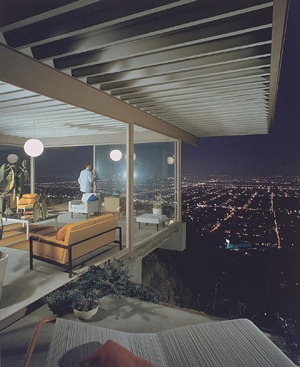

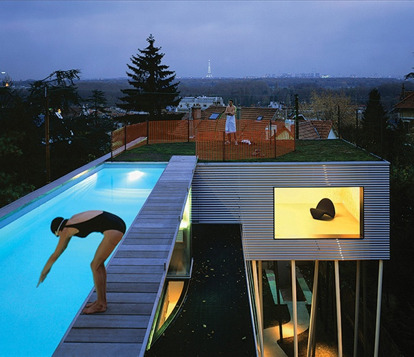
Shulman’s work really shows the lifestyles that come along with some structures. I enjoy the fact that his subject matter in these images are really appealing, expensive structures that accommodate wealthy people, it’s rare in a world driven by sad scenes and dramatic imagery (which I also enjoy). I think the purpose of the building must have been import for him, as he usually shows a valuable asset to the home (pool, view, etc.) and the people enjoying them. I love the stylization of the images to, they almost feel like a movie set or something from a James Bond movie.
https://www.archdaily.com/29457/julius-schulman-1910-2009
Distortion
Distortion in photography can be understood as being an optical illusion or effect is produced as a result of various techniques or processes, where the straight lines in an image appear curved or distorted. The overall effect is that the resulting images appear deformed or radically misshapen or twisted, though the range of effects, and indeed the strength varies depending on which lens is used or which position the camera is placed in, relative to the subject. Within photography, distortion falls into two distinct groups: perspective distortion, and optical distortion. Distinguishing between the various forms and processes of distortion is important, as each effect has a distinctive look, and also a distinctive process which is carried out to achieve it.
Optical Distortions
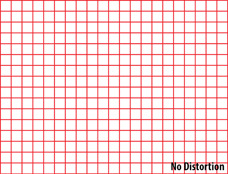
Optical distortion refers to any instance where the distortion results from a lens error, as no lens can completely prevent distortion, given the shape of the lens itself. There are three types of optical distortion; barrel, pincushion and moustache distortion.

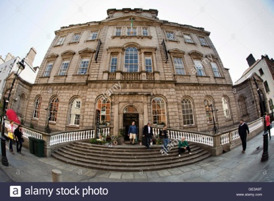
hese images show Barrel Distortion. This type is commonly seen on wide-angle lenses where lines appear curved inwards, reminiscent of the convex shape of a barrel. It results from an image where the field of view of the lens is wider than the image sensor, essentially squeezing the image. Barrel distortion occurs with the majority of wide-angle lenses, as well as with zoom lenses with short focal lengths, though the degree of the distortion is mostly dependent on the distance between the camera and subject.
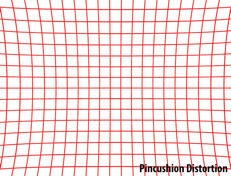
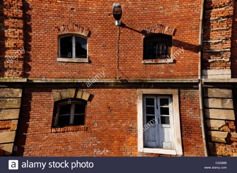
These images show Pincushion Distortion. This is the opposite of barrel distortion, as the lines appear to curve outwards. This results from the lens’ field of view being than the size of the image sensor, and so the image appears stretched. Pincushion distortion occurs primarily with telephoto lenses or zoom lenses, as image magnification in the photo becomes greater towards the edges of the frame. As with barrel distortion, pincushion distortion is also difficult to prevent through changing lens, and can be fixed simply in post-production.
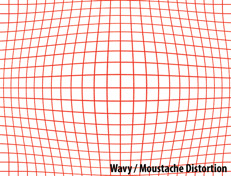

These images show Moustache Distortion. This form is harder to spot, showing a bend towards the centre of the image, as the lines curve both inwards and outwards. Due to this, it is also referred to as ‘complex distortion’. This form is much more difficult to deal with, both in prevention and remedy, as it cannot be dealt with in the same way that the two other optical forms can. If this is attempted, the curves will become much more exaggerated towards the edges or centre respectively, thus specialised software must be used to fix this distortion.
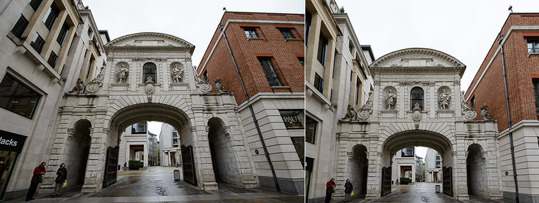
This form of distortion is the most common, resulting even from the human eye. Perspective distortion occurs when an object is situated too close to the camera, as the proximity causes the image to distort when trying to represent the three dimensional proportion of the object in 2D. As such, this is not caused by a lens error, and can be prevented through test shots and varying the composition of your image’s subjects. Although many lenses claim to reduce this effect, they merely force you to change position, altering your image from that on the left, to the image on the right.

Although all distortions can be used deliberately to produce a creative effect, the use of curvilinear lenses is arguably the most recognisable. Whereas Rectilinear Lenses produce a natural effect with straight lines stretched towards the edges of the frame, curvilinear or fish-eye lenses result in a highly distorted image where the lines are unnaturally curved.
Fixing Distortion
There are many ways to fix distortion in your images. Given the wide variety of methods it is useful to categorise them based on the point in your shoot that you use them.
Pre Production
As mentioned, particular lens is advised to avoid particular forms of distortion. For example, To reduce barrel distortion, specific lenses can be used, such as the Nikon 14-24mm f/2.8G, which aids distortion reduction, however it is important to note that this impacts negatively on the weight of this and other wide-angle lenses. Another example of useful lens for reducing distortion is a tilt-shift lens. This lenses optics can be tilted and shifted in relation to the image sensor. Tilt shift lenses also have the ability to swivel, changing the cameras perspective but keeping you unchanged, which reduces distortion. Research into the best lenses for your project should always be undertaken well in advance in order to save time and effort wasted on fixing distortion problems in post production.
Mid Production
The easiest way to reduce distortion during your shoot would simply be to change position. You may be too close to your subject, making features appear big and domineering in the frame, and vice versa. This is particularly important when doing architectural photography, because a change in the scale can result in your subject appearing unfamiliar, which can result in the purpose of your shoot being ruined.
Post Production
Distortion can also be corrected in post-production, using software such as Adobe Photoshop or Lightroom. One tool you can use on Photoshop to correct distortion is the adaptive wide angle tool. This can be found in the filter menu. Using the tool in auto mode you can manually draw lines down your image where you see the edges of a structure becoming distorted. As you click the tool corrects any curved lines, removing the distortion.
Idea
The V & A museum in Dundee is a very interesting building from many different angles, almost resembling a beached wale or some sort of ship. According to the construction company “bam”, the museum is effectively two separate three storey buildings, joined at roof level. Surrounding Scottish cliffs were the inspiration for the outer walls. The curves are formed from a series of concrete panels, each a different profile, inset with lighter coloured pre cast concrete slabs. I think this would be a great building to shoot as we have an amazing building in its entirety to photograph but also many opportunities to get close in detail shots. The contact number is 01382 411611. I plan on shooting this at time different times. The golden hour and the blue hour. I think sunlight could bounce of this building in a very interesting way but I also think the imposing shape and the fact that it is basically a docked building could make the blue hour work even more. A return train ticket to Dundee is around £24.




I have emailed asking about access building am waiting for a reply, if I don’t get that I will call and if access if restricted then I’m going to go with the college building itself. It’s easy to get access to, the structure has a lot of elements too it and is genuinely a nice building. Also I know I wont get knocked back from shooting there and I’m getting tired of emailing/phoning places for no result.
https://www.e-architect.co.uk/dundee/v-a-dundee
https://www.bbc.co.uk/news/uk-scotland-tayside-central-45432993
https://www.bbc.co.uk/news/uk-scotland-tayside-central-45432993
https://www.bbc.co.uk/news/uk-scotland-tayside-central-45432993
Structure Evaluation
In this brief we were tasked with capturing five images of architecture. 3 of these shots were exteriors, two included controlled perspectives and one included the complete building, followed by 2 interior shots.
The building that I chose to capture was the City of Glasgow Cathedral Street Campus building. I chose this setting for my shots because I knew I would benefit from a building which was not only architecturally interesting and significant, but which I could gain complete access to. A number of other buildings I had considered were very restricted in what you were able to capture, or didn’t permit photographs at all. I also knew this building pretty well and knew that there were a lot of photographic opportunities there.
Staring with the wide angle exterior shot, I found this to be the hardest of my set of images to complete as it was very difficult to find an angle that would fit the whole building in and look good at the same time. I was using a 18-55mm lens because it gave me the widest angle I could get. I tried to capture my image further down the street to get a better angle, but there were a lot of distractions like bins, lampposts and bus shelters. Cars would also zoom past a lot and obstructed the frame, making it look cluttered at times. I considered doing a longer exposure to get the trails of the car lights in but this to me was a bit unnecessary and I wanted to capture the building during it’s time of use - the early afternoon. I edited my image very simply, removing a few people who stepped in my frame and some bins but very little was done. The perspective control was simply done on Bridge, using the transform tool to auto adjust the perspective control, I used this for all my images but used different settings each time.
I then moved onto to focus on my exterior detail shots. The college building has very interesting shapes and lines, with a certain uniformity to it all so I focused on that. The first wider angle image shows this with a semitropical grid towering down and windows peaking out behind them, I chose to show this because the modernism is really striking and when I first saw the building it gave me a futuristic and very scary feeling but as I grew to know it, it became far more comfortable and I realised it was just a place for structured creativity. I think the building really screams that, and I hope it comes across through my images. The second exterior detail shot was again captured using the lines of the building but this time I wanted to show more of the curvature on the block architecture and how shadows get stuck in very interesting places due to the building’s nature. I really enjoy the light in this image, everything subtle and you can see a lot of individual tones in the layers of glass and metals, and it almost doesn’t look like the same building.
The interior shots were very tricky, the college has a lot of opportunities for great photos but when spoiled for choice I wanted to get the most original shots possible to stand out. One thing I certainly wanted to include in these images were the students, lecturers and/or staff members. This is to convey that this building is vibrant, and filled with individuals that all play a role in the function of the buildings purpose. I thought getting a low angle shot from the top of the main stair case would achieve this as it is the busiest place for people and the leading lines that you can see with the balconies going all the way up is very interesting. I wish I spent a bit more time with this shot and waited for a better moment, although I think some people in this image convey my point, others just make it look busy, they are really standing/walking in positions. For my final interior shot I definitely wanted to get the City of Glasgow sign in, as in my view this is the most iconic aspect of the building and I knew the celling windows would give me a good view of it. Those windows can form excellent shadows at the right time, with the right weather and I wish I had come back again to see if could get anything better with that, but I do enjoy this image. I think the window gives the image more depth and the lines and grids make this photo a perfect fit with the others.
I enjoyed this project more than I thought I would and learned that taking photographs of buildings and architecture is a lot harder than I originally thought. If I were to do this again I’d definitely spend more time with the building and look for a lot more angles. I also think investing in a extremely wider fixed lens would be a good idea.
0 notes
Text
Did 2017 suck? On a collective level, the short answer is “yes,” but make no doubt about it -- Music as our always reliable creative backbone and support system through these troubled time had an outstanding year. There were so many great albums coming from every direction of the sonic spectrum that if this year’s list had 20 more spots to give, it would have been easy to fill each and every one of them. We got the best out of everything this year: Familiar favorites continuing to excel at what they do, reunited comeback surpassing expectations, breakouts from new artists who are just getting started in writing their own legacies, guitar rock far drom dying, the two best young rappers once again dueling it out for the throne, and others who focused their energy and voices to resist, preach change, or at least try to make sense of this world. We escaped it together. We got our hearts broken together. We holed up in our heads together. We got angry together. We grieved together. We found hope on the other end of darkness together. The 30 Best Albums of 2017 are just as much a part of us as we are them.
30. Liars - TFCF [Mute Records]
In Liars’ world, nothing is ever as it once was, and no greater are those words true on the band’s eighth full-length TFCF. It’s the first album where the outfit is now working entirely through the creative psyche of founder Angus Andrew since the dissolution of his partnership with its other primary creator following the promotion of 2014′s laser raver Mess, and with that, Andrew uses TFCF as a formal vessel to mourn that loss through Liars’ endlessly shape-shifting body. Its minimalist shift is jarring when held against the band’s latter outputs where dance mechanics and electricity ran through in no short supply, and no turn is ever predictable. In a sense, this feels like Andrew reclaiming a sense of his own identity through the sonic outlet he has poured two decades of exploration into, and while the listen harbors an underlying trepidation in going at it alone, it’s also an adventurous fresh start for the revered noisenik’s work that reminds us why we signed up to tag along for the journey to begin with.
29. Charlotte Gainsbourg - Rest [Because Music]
One of the most peculiar angles to observe about Rest, Charlotte Gainsbourg’s third proper studio effort and first since 2011′s excellent Beck-assisted effort IRM, is that it’s a grief album that sounds nothing of darkness, and dances in the face of death. While the background context of much of it has been discussed by Gainsbourg herself (her half-sister and photographer Kate Berry passed away in 2011,) the actress / musician has surrounded herself with fellow French sound designers Guy-Manuel de Homem-Christo of Daft Punk and producer SebastiAn in a manner that outlines her catharsis in neons and clean-lined synthesizers that, even for a mpm-Francophone-fluent listener, feel robust with life. Ultimately, the album isn’t so much about how death has taken its toll, but rather been pushed far enough away from Gainsbourg to a point where it can co-exist with the honors of what we must appreciate living for as well. So is the mark of an artist who often deters from cliché, and instead poses a challenge to procenceptions.
28. Spencer Radcliffe & Everyone Else - Enjoy the Great Outdoors [Run for Cover Records]
In short, Spencer Radcliffe is an anomaly. The multi-instrumental songwriter has quietly become some of your favorite artists’ favorite artist for years now thanks to his treasure trove of self-released efforts and experimental oddities strewn across BandCamp, but ever since he signed with Run for Cover Records to release 2015′s proper debut full-length Looking After, that sense of stability has wrangled in the eccentricities going on his head without trampling them. On Enjoy the Great Outdoors, Radcliffe’s friends help bring his sound outside of the metaphorical bedroom, and the result is a long, winding day trip journeyed on ragged guitars, grumbling percussion, and high as a kite existentialism appropriate for coastlines drives, camping retreats, sand-sprawled beach days, or maybe just a lazed nap in the backyard hammock. It’s music for a mindset rather than a concrete destination.
27. Japanese Breakfast - Soft Sounds from Another Planet [Dead Oceans]
Michelle Zauner has traveled across the entire universe of sound at a speed faster than light to evolve to the point where she is today as an artist. Psychopomp, last year’s debut album from her band Japanese Breakfast, was a promising reintroduction to the singer-songwriter we had once known as the lead vocalist for the Philly indie punk outfit Little Big League. It carried the weight of a heavy mourning sound on airy vestiges of dream-pop while embossing Zauner’s penmanship, and on its follow-up Soft Sounds from Another Planet, it’s as if that gauzy cloud has drifted out of view. What we see is a vivid realization of the wonders in her art, traveling across a galaxy of sound where crystallized synth-pop, big romantic ballads, and grizzled indie rock can coexist without impinging upon each others comfort zones. Zauner may have put herself in the storyteller’s chair of writing a sci-fi love story with this effort, but it turns out that no matter the medium, those emotions are universally binding.
26. Margo Price - All American Made [Third Man Records]
Midwest Farmer’s Daughter, last year’s debut effort from outsider country songwriter Margo Price, wasn’t just a breakthrough by merit of putting in a decade’s worth of starving artist work in someone who never folded under the weight of rejection, but also because it was a survival story that sang the life out of hardships faced in between, lending credence to her “authenticity” as a genuine country songwriter in the process. Following the 2016 election, the stories behind this year’s sophomore follow-up All American Made didn’t take as much time to collect themselves as she flips her perspective onto world where women still are fighting for respect and equality, or there’s a need to advocate action rather than thoughts and prayers for the country’s undercut farming industry, all scribed in wry one-liners and a modern spin on traditionalism. If you want an accurate picture of what your neighbor is up against, Price is the precisely the hard-working voice to make that call for empathy.
25. The World Is a Beautiful Place & I Am No Longer Afraid to Die - Always Foreign [Epitaph Records]
The World Is a Beautiful Place and I Am No Longer Afraid to Die have done everything in epic proportions since a creative big bang placed them in the music universe. 2015′s excellent sophomore outing Harmlessness delivered an ambitious self-care guide vesseled in mythological folk tales and song sequences that borderlined a night at the indie-emo opera, but with it pondered where the CT collective would go after climbing Everest. The answer is back down to Earth, as their third studio effort Always Foreign is the band’s most compact work to date, refining their songcraft with sharpened hooks and trimming away the meandering excess without necessarily watering down their epic appeal. Yet, what a scary, alien place this world they’ve gravitated back down to has become since their last chapter. If Harmlessness fought to make space for a sense of humanity in every particle of light in our bleak, existential throes, Always Foreign is defined by leader David Bello accepting that most everything around us is going to remain terrible despite us naïve hopefuls’ best efforts. Drastic turns to brazen righteousness just may be the survival tactic needed to see us through to tomorrow.
24. Vagabon - Infinite Worlds [Father / Daughter Records]
Brooklyn’s best kept secret weapon is now the world’s to share. Following the release of a coupling of demos and an EP, Cameroon-born and NYC-based songwriter Laetitia Tamko, b.n.a. Vagabon, and her debut full-length Infinite Worlds collects her migrated experiences alongside the boundary-less perspective of the indie rock universe. It’s title is an ideal descriptor of its sound, as the listen is a layered lo-fi adventure of electric guitars and bedroom synths that not only defines the DIY songwriter’s own possibilities to create for herself, but for a scene stymied by monotonous representation. As a black female voice in a densely white scene, Tamko’s pursuit for the authentic and her own identity despite those odds steers the wheel away from sonic predictability. She’s demonstrating with effect how outside exposure doesn’t necessarily have to lead to a total reconstruction of the home’s foundation. A fresh coat of paint will do.
23. Ratboys - GN [Topshelf Records]
In the soil of the indie rock underground, a new crop of alternative takes on country continues to sprout. The Chicago duo Ratboys wear their threads well, sounding simultaneously scrappy and well-collected from the inside, especially in the latter through the songwriting prowess of vocalist Julia Steiner reflecting as much of her own personal experiences into their songs as she does the emotions connected to them. Their 2015 debut AOID safely laid the groundwork for their brand of twangy indie rock, and here on GN, they continue sculpting their identity in a grainy field quickly saturating itself of Saddle Creek-era devotionals by telling stories that only Steiner, alongside primary cohort and guitarist Dave Sagan’s scene-setting assists, can. Every step along their long and winding journey yearns for the close comfort of home – seemingly eternally out of reach – giving the listen a wistfully warm undercurrent that makes for a pretty good imitation of it.
22. Kindling - Hush [6131 Records]
It isn’t easy being an indie rock band who has to follow in the footsteps of a very distinct Western Mass pedigree. The outside world still compares every band from the area to the ‘90s alternative lineage of Dinosaur Jr., the Pixies, and Sebadoh with boxed-in sonic schematic assumptions. The Easthampton quintet Kindling certainly love their reverb, but on their sophomore breakthrough Hush, they have created a shoegazing sonic boom in the valley that stays loyal to the area’s legacy of loudness while putting their own stamp of hardcore influences on an otherwise lush atmosphere of rock. There are just as many moments throughout the listen that double as invitations to the pit as their are celestial drifts, with guitarists Gretchen WIlliams and Stephen Pierce’s dueling vocals becoming part of its soundscape at every turn. Sure, there are its flickering moments of golden age alt-rock stomps and whirring shoegaze in its booming production courtesy of Justin Pizzoferrato (Dinosaur Jr., Speedy Ortiz), but Kindling is pushing those sounds into a new direction that leaves the past in star dust.
21. LCD Soundsystem - American Dream [Columbia / DFA Records]
James Murphy has realized that putting the final nail in LCD Soundsystem’s coffin didn’t have to be a thing if he didn’t want to, or because it’s how other artists did their business, and that only he could decide under what terms their story ends. What LCD Soundsystem has become during the in-between on American Dream is a timely and necessary comedown of their catalog’s euphoria during these anxious times does not hurt either. If 2010′s This Is Happening was the sound of hundreds of black and white balloons falling from the rafters of Madison Square Garden in a swan song of celebratory fashion, then American Dream is hearing each one of them attempting to crawl toward your feet before they deflate and shrink to the floor in one of their last moments of exhale. It’s a darker and heavier album compared to the confetti and disco ball flashes of the past, with the blue skies and puffy white clouds on its cover offering a patronizing oppression -- Quite literally the new age sounds of death from above.
20. BROCKHAMPTON - Saturation II [Empire / Question Everything, Inc.]
As usual, the discussion around hip-hop this year will mainly revolve around Kendrick and Vince as two of the year’s biggest standouts once more, but the cross-country collective known as BROCKHAMPTON have secured their place as the rap game’s biggest breakouts. Saturation II isn’t even the only album they’ve put out this year – it’s the second in a trilogy that began in early summer and will be imminently concluding with a third installment – but it’s the effort that has rightfully caught buzz beyond the Internet forums where this self-professed “American boy band” joined forces. If their end game is world domination, then their brand of pop-infused, Kanye-worship hip-hop is good way to get there, and it doesn’t hurt that the team effort of every member bringing a different story to the table makes Saturation II play like a non-stop assembly line of crew anthems.
19. Moses Sumney - Aromanticism [Jagjaguwar]
After years of relentlessly molding his craft of experimental electronic soul, Moses Sumney finally puts the finishing touches on his wondrous cynicism with his debut full-length Aromanticism. The album has the characteristics of an album that appeals to emotional masochists, but it’s when Sumney creates these temporal flickers of light within his sound where even the darkest paths of the rabbit hole uncover a beauty in the despair. Radiohead, Bon Iver, and Sufjan Stevens have centered entire careers on existentialism with more elements, built for larger stages, yet Sumney proves here that he needn’t expand much beyond his natural body to achieve this. It can feel almost uncomfortably voyeuristic, as if we’re privy to an intimate encounter, except Aromanticism is the opposite of that: A quiet cry into the infinite, hoping patiently that some day someone reaches back.
18. Big Thief - Capacity [Saddle Creek]
If you want to sit down with a few good stories mired in truth, tragedy, and fiction, then Adrienne Lenker is your best summer read. Last year, the Brooklyn-based songwriter turned the music world’s ear her way when she and her band Big Thief released their promising debut Masterpiece astutely in the right avenue of ramshackle indie rock on Saddle Creek, and its sophomore follow-up Capacity builds on the upward interest by penning several new chapters of prose haunted by the past and subtly beautified by the ornate features of folk rock. It’s by no means in comparison to the rest of summer’s sounds a booming listen, but is its own force of nature that forces you to hang onto Lenker’s every word with full attention to reap its riches. City slickers often make great escapes to seek out this kind of peace and quiet in retreats, but Big Thief’s solitude finds its way to you without ever leaving home.
17. Kelela - Take Me Apart [Warp Records]
Kelela has been an influencer in spilling a dark wave from the dance and R&B undercurrent into the collective mainstream conscious since appearing virtually out of nowhere in 2013. Through mixtapes and EPs, her futuristic style wrapped grime, dubstep and modern techno’s rattling walls around her sensual moves and ethereal vocal presence, and finally, on her debut full-length Take Me Apart, her hallucinogenic formula of R&B pop becomes more lucid than ever as Kelela continues to mutate every influence since the days of growing up (as she puts it) “in the ’burbs listening to R&B, jazz and Björk” and beyond together. Her art of seduction has also moved onto a universal plane here as she navigates the messy world of late night hookups, drunken texts in the early hours of a restless post-breakup, and eventually, moving on for the better. While still soft and pillowy, Kelela’s voice has never sounded in such focus as it does here, which is to say her intentions gleam through the soundboards loud and clear.
16. Jay Som - Everybody Works [Polyvinyl Records]
The work of 22-year-old Melina Duterte exists in its own space, because that’s exactly where it was born. As a fledgling songwriter living on the outskirts of the Bay Area, she began recording music under the online name-generated moniker Jay Som over the course of the past five years, haphazardly posting them onto her BandCamp page without caution before peaking the interest of venerable indie rock label Polyvinyl Records. On her debut full-length Everybody Works, she puts in the effort of tenfold humans to deliver an album so rich in dream-pop textures and visceral fuzz rock that she’d have you believing more warm bodies were standing right next to her during its recording. And yet, despite Everybody Works many layers, her proper introduction bares the markings of the warm insularity of the bedroom where Duerte recorded every instrument on her own doing. It’s filled with enough tenderness to compliment its intentionally rockist ways, bringing to the forefront a unique, introverted identity that blurs the line drawn between proper studio mechanics and the magic of homespun spaces.
15. The National - Sleep Well Beast [4AD]
The National are one of the most consistently great indie rock bands to survive the NYC Aughts scene and all of its history that has for the most part become anecdotal enough to fill up the pages of Lizzy Goodman’s Meet Me In the Bathroom. Consistency can be its own trap, however, as it can lead down the road of creative sameness,but their seventh full-length Sleep Well Beast feels like a needed shock to their system even if so much of it tip its hand to what made their early catalog bold. There’s Matt Berninger and his wife Carin Besser reconnecting his prose with matters of lovers’ quarrels and commitments, and just the right amount of darkness swallowing up the night that has become synonymous with the National’s relationship with the city. Funny how they actually had to flee the city to record the album, and that wilderness experiment is what ends up feeding Sleep Well Beast its electricity as the quintet refit their machine with artificial limbs and heartbeats. For the National, success in grandeur is in the way they convey intimacy.
14. Converge - The Dusk In Us [Deathwish Inc. / Epitaph Records]
Holding The Dusk In Us up against any of Converge’s other albums results in this one joining the superlatives of added consistency as one of the strongest catalogs reigns in the hardcore and metal scene, and how they’re a thousand miles away from their nearest peers. Their 9th full-length in particular excels in the way that the Boston heavyweight’s brawny existential substance injected into each track isn’t due to the concept itself or focusing on a certain aspect of their sound, but instead embracing each member’s strengths and ability to bring out the best in what they’ve collectively refined as singularity when in each others’ presence for the past 27 years. According to frontman Jacob Bannon, not even parenthood or aging have changed the way he and his ‘mates approach writing songs in the wide eyed way they did when they were just kids, since this listen transcends those notions as a timeless anomaly of hardcore perfectionism. If anything, time only serves to emboss Bannon’s scrapes for meaning or light in an increasingly dark world despite the burrowing anxiety of breakdowns they flail into.
13. The War On Drugs - A Deeper Understanding [Atlantic Records]
By design, A Deeper Understanding, isn’t actually all that difficult to understand. For years, the War On Drugs’ mastermind Adam Granduciel has been perfecting his craft as a new age highway vagabond by bridging the gaps between classic heartland rock and synthetic pastures, and on his Philly band’s major label debut for Atlantic, he comes closer than he ever has to getting that formula entirely right. Those years on the independent scene seamlessly flow from their tributaries into the mouth of high end studio precision – Not that much of a departure from where 2014′s craft beer classic Lost In the Dream left off, but rather a widescreen continuation of its colors with more lucid light and memory behind them. Whether your journey leads you down winding mountain roads or a stretch sandwiched between endless field, A Deeper Understanding can make each of those landscapes bolder, and even if life doesn’t take your there physically, Granduciel’s music still has that power to.
12. Slowdive - Slowdive [Dead Oceans]
The challenge facing a reunited Slowdive two decades since their last record is how a band of their legacy status goes about reinventing the wheel of a genre they helped mold, but has since seen its shape stretched to a breaking point. . Previous to Slowdive, their only attempt at transformation came with the divisive electronic experiment and initial death knell in 1995′s Pygmalion, but the modern age is more open-minded to these kind of creative risks. While Slowdive orbits closely to the cosmic tour de force of their debut classic Slouvaki with greater consideration to concentrating its deeper impact, the album indulges in the dense atmospheric properties of its genus offshoot post-rock, while other moments point to how without Slowdive, there might not be a Radiohead. A formidable comeback is one thing, but Slowdive proves the band’s legacy has not only withstood the test of time, but that they’re active participants in keeping it alive better than where they left it.
11. Girlpool - Powerplant [ANTI-]
Before the world got big on them, Girlpool were just two teenage friends and budding songwriters sitting in a bedroom with a guitar and a bass, wide-eyed with ideas, but not really sure where any of them would lead them. That tiny childhood bedroom where Girlpool, now out of the teenage woods, came to life is no longer big enough to fit all of their world experiences and emotions resonating in daily lives, yet on their sophomore effort Powerplant, they’re able to add more substance to their minimalist sound without necessarily squeezing small-spaced intimacy completely out of the picture. The project is still primarily the vehicle of Harmony Tividad and Cleo Tucker, but this is the first effort that includes built-in drums by Miles Wintner as well as an added supply of electricity in the studio that makes that tiny room style of theirs boom from wall to wall. If their music was a thing of line drawings and outlines before, then Powerplant paints the world around them in full technicolor with a sound that comes through the speakers as wholly three-dimensional.
10. King Woman - Created In the Image of Suffering [Relapse Records]
Bay Area artist Kristin Esfandiari has been refining her brand of doom and gloom for years in a duality between her metal band King Woman and her shoegazing solo outfit Miserable. Each of those facets play an integral part in turning a confident new corner, however, for the former on their immaculately grim debut full-length Created In the Image of Suffering. In our current political climate, it’s a resistance necessity, as Esfandiari heaves a wrecking ball into patriarchal tropes and theological repression. She damns humankind’s origin folklore into a sludgy, gauzy hell, and reconceives it through the womb of terrifying transcendence. This listen scrapes into bone and marrow under sunburned skies as much as it does ominous thunderclouds, and ushers in King Woman as the new savior of a world whose limits stretch well beyond metal boxes, making for the year’s top honor in its class of heavy.
9. Lorde - Melodrama [Republic / Lava Records]
Lorde still had almost half a decade left on the clock as a teenager when she released her breakout debut Pure Heroine, and that reminder brings with it the realization than not even all of the fame and accolades coming at her fast could protect her from a growing pain so pedestrian as young love and heartbreak, presented with #nofilter on Melodrama. The few, improvable criticisms of Pure Heroine barely exist here. Where that album’s highlights were in its low sizzle stunners of teenage festival anthems, Melodrama has something different going for it altogether in its post-breakup party night concept that strings the narration along from start to finish through a synesthesia of sound and color wired with vivid detail. These sensory synapses wouldn’t be set off without Lorde’s lyricism, as her past work’s vaguely universal themes of being a shoulder-shrug millennial give way to hyper-specificity in both pain and recovery. 20 is a beautiful age to start seeing the world for what it really is, and we’re lucky to be living it through Lorde’s eyes.
8. Julien Baker - Turn Out the Lights [Matador Records]
Julien Baker probably sees her growing position as a patron saint of sadness as a shared experience of universal catharsis much like how we are expected to grieve and deal with personal traumas in our own way. Listening to her sophomore effort (and first for Matador) Turn Out the Lights indeed does sound like an emotionally wrenching experience for an artist to undertake in the studio in the way she leaves no naked thought uncovered from our ears, but that she has managed to take the foundation of what was otherwise a skeletal sound on her 2015 debut Sprained Ankle and transform it into a fully fleshed body that hits our souls with deeper impact is her super power. Her songwriting style remains largely cavernous by treating her electric guitar like a strummed acoustic, occasionally allowing the organ hum and piano keys sink, but the inclusion of Sorority Noise’s Cam Boucher on clarinet and saxophone can transform a song like “Appointments” from a soft hymn into a therapeutic gospel post-rock symphony. Elsewhere, she crafts explosive self-care ballads or relies on Camille Faulkner's strings as turnbuckles while wrestling with life's big questions. It's impossible to find fault in Turn Out the Lights, considering the depth in Baker's EQ's through song is a gift that helps us all cope, too.
7. Sorority Noise - You’re Not As ______ As You Think [Triple Crown Records]
Sorority Noise are a rock band shoved under the emo banner, probably because they talk about the quiet things few have the guts to spill in public out loud. Life, in reality, is filled with messy moments, and they’re at the forefront of an incredibly diverse fourth wave landscape that’s carving out their own space in the modern indie rock cannon proper for coming of age discussions on existentialism, sociopoltiical issues, self-care, and in the Connecticut quartets case on You’re Not As ______ As You Think, a skeptical faith, grief and death. Here, they’re tempering pop-punk riffs into wall-scaling post-rock climbs, puddling effects, and echo chamber vocals that dissect complex spiritual dialogues in light of life’s murkier moments. There’s no social taboo too fearful to tackle with humility here, and they’re all framed inside of quotables and sing-a-longs that will undoubtedly be tattooed into the memories of listeners for years to come. If this isn’t an ideal way to pay your final respects, then nothing else is.
6. PRIESTS - Nothing Feels Natural [Sister Polygon Records]
PRIESTS burst onto the scene back in 2014 with an EP entitled Bodies and Control and Money and Power, and forcibly stated their intentions on taking back the second and fourth words specifically in regards to inalienable human rights. That being said, the D.C. quartet’s full-length debut Nothing Feels Natural wasn’t something immaculately conceived as soon as the country woke up on November 9th to the American nightmare ahead. Its themes are subjects that needed public outcry all along, and yet, are made all the more critical in dialogue as we stand here in discontent today. Yet, Nothing Feels Natural does more than just protest status quo and rail against systematic injustices. Every great once in a while, the punk scene is in need of a new voice of wreckoning to kick it upside down, and PRIESTS’ fluid cross-style of sounds in the realms of existentially exhaling post-punk or cantankerous free jazz make Katie Alice Greer’s incendiary statements all the more evident.
5. Kendrick Lamar - DAMN. [Aftermath / Top Dawg Entertainment / Interscope Records]
To Pimp a Butterfly placed Kendrick Lamar on a pedestal as not only a savior to the rap world, but one wielding his power for greater purpose in calling out the country’s unresolved racism. DAMN. is past the point of addressing the problem, though, and now that Lamar’s focus has been broadened, he’s doing what we already knew him to be, and that’s humblebragging as the self-proclaimed best living rapper right now. There is no distinguishable commitment to a particular vibe on this outing, as DAMN. is more of a singles-driven affair where instead of one story bleeding from one track into another, you get 14 versions of K-Dot that stand on their own while still piecing together a bigger picture, neatly tied together by the bookends of the Top Dawg origin story from beginning to end. In between, Kendrick is switch-hitting between shutting down his critics and sinking his teeth deep into his own dark existentialism. He’s just a man after all, who realizes his life and success is a gift not to be taken for granted granted, and on DAMN., Lamar ensures every moment counts.
4. Paramore - After Laughter [Fueled by Ramen]
Paramore’s 2013 self-titled effort was a surprising reboot that saw the band growing up with tough love realizations. It was also the moment they began finding their own lane in the music universe at large with a sound that was as striking as Hayley Williams’ dye job thanks in part to working with atmospheric alt-rock producer Justin Meldal-Johnsen (M83, Nine Inch Nails.) Despite its success, life hasn’t gotten any more fun for the pop-punk survivalists on After Laughter. The band may have made amends with original drummer Zach Farro, but it’s an effort standing in the shadow of loss following the messy departure of bassist Jeremy Davis and Williams’ crumbling marriage. The business of being celebrity is hard times, and here, Williams lets out one deep sigh in widescreen format filled with arena-ready pop-rock she and her ‘mates only began to experiment with four years ago. It’s committed fully to the sparkle and shine of what they always were, except now they’ve figure out a way to glow without resorting to being fake happy.
3. (Sandy) Alex G - Rocket [Domino Records]
It should be maddening to listen to an artist trying to be too many things at once, but it’s what has made the career of prolific Philly songwriting wunderkind Alexander Giannascoli so enthralling. As (Sandy) Alex G, his many releases over the years have been a grab bag of indie rock and esoteric influences that when hodgepodged together somehow shape themselves into a semblance of sounds that makes sense together as much as they do apart, and on Rocket, the variations are more abundant than ever. The end result is the songwriter’s most collected release while establishing him as one of his generation’s ebst musical multi-tasker. Heard here in his indie rock fashion line is wearing everything from country, hardcore, to his brand of Frank Ocean-endorsed bedroom pop convincingly, and at this point, it would actually be a letdown at this point if he didn’t pander toward these patterns criss-crossing into one another while creating these strangely beautiful moments of parallel. A world where (Sandy) Alex G didn’t do that would just be too grounded, and Rocket is proof that he is meant to be far out orbiting the Earth.
2. Vince Staples - Big Fish Theory [ARTium / Blacksmith / Def Jam]
Over the last three years, Vince Staples has either released a mixtape, EP, or full-length album that have turned all ears inside and out of the hip-hop world in his direction. He has in jest referred to the movement going into his sophomore follow-up Big Fish Theory as “Afrofuturism,” referencing a millennium from now as its sonic starting point, but being the humblebragger who leaves any assessment in his listener’s hands, the thought of putting any kind of label on it would be a failed attempt at restraining its orbiting persona. With his stock continuously on the rise, Staples is in the moment here, ruminating from within the id against a corrupt world as his backdrop, putting every word to pen as if it’s his last and his legacy depended on it. He’s at the cutting edge with where hip-hop is headed, working with LA beat scene wunderkind Zack Sekoff on a majority of the LP’s tracks, a few twisted ventures with pop deconstructionist SOPHIE, as well as bass-heavy DJ duos GTA and Christian Rich. If you were to remove the rhymes, you’d still be left with a fashion-forward avant techno album, but alas, Staples puts the boom and static on the same level as his ego, and we get the year’s most adventurous foray from rap music.
1. Zola Jesus - Okovi [Sacred Bones Records]
Zola Jesus returned to her haunted home Sacred Bones for her fifth and career-best full-length Okovi, and the road leading her there has been a long and winding one. Her dark art began forming in the corners of noise and industrial gothic pop in the late Aughts, and after attempting a pop crossover with it on 2014′s Taiga, her experiment in grande ambition has done nothing but inform her method in writing an album that puts every facet of being onto the same soundscape. Here, she uses that unbreakable foundation to process a series of heavy life-altering events in a manner that only Nika Danilova can when it comes time to holding our existence up to questioning. On paper, conversations on illness, death, and depression can sound incredibly grave, but even in life’s darkest moments, Danilova’s siren calls amid ornate transcendentalism finds a way to the light, and it’s that journey filled with agony that makes Okovi – the Slavik word for “shackles” – a visionary breakthrough. It’s a reminder than regardless of how overwhelming and even terrifying it can be just to be alive, life would be taken for granted if it weren’t for pain reminding us to live it to the fullest. In 2017, we may have let our nihilistic fears shake us, but we also fought for every ounce of hope as well. No other album embodied that struggle better than Okovi.
#best of 2017#zola jesus#vince staples#(sandy) alex g#paramore#kendrick lamar#priests#sorority noise#lorde#girlpool#king woman#slowdive#the war on drugs#converge#the national#jay som#kelela#big thief#moses sumney#brockhampton#lcd soundsystem#kindling#ratboys#vagabon#charlotte gainsbourg#the world is a beautiful place & i am no longer afraid to die#margo price#japanese breakfast#spencer radcliffe & everyone else#julien baker
0 notes